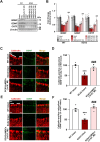Post-symptomatic administration of hMSCs exerts therapeutic effects in SCA2 mice
- PMID: 39521966
- PMCID: PMC11550562
- DOI: 10.1186/s13287-024-04020-8
Post-symptomatic administration of hMSCs exerts therapeutic effects in SCA2 mice
Abstract
Background: Defects in the ataxin-2 (ATXN-2) protein and CAG trinucleotide repeat expansion in its coding gene, Atxn-2, cause the neurodegenerative disorder spinocerebellar ataxia type 2 (SCA2). While clinical studies suggest potential benefits of human-derived mesenchymal stem cells (hMSCs) for treating various ataxias, the exact mechanisms underlying their therapeutic effects and interaction with host tissue to stimulate neurotrophin expression remain unclear specifically in the context of SCA2.
Methods: Human bone marrow-derived MSCs (hMSCs) were injected into the cisterna magna of 26-week-old wild-type and SCA2 mice. Mice were assessed for impaired motor coordination using the accelerating rotarod, open field test, and composite phenotype scoring. At 50 weeks, the cerebellum vermis was harvested for protein assessment and immunohistochemical analysis.
Results: Significant loss of NeuN and calbindin was observed in 25-week-old SCA2 mice. However, after receiving multiple injections of hMSCs starting at 26 weeks of age, these mice exhibited a significant improvement in abnormal motor performance and a protective effect on Purkinje cells. This beneficial effect persisted until the mice reached 50 weeks of age, at which point they were sacrificed to study further mechanistic events triggered by the administration of hMSCs. Calbindin-positive cells in the Purkinje cell layer expressed bone-derived neurotrophic factor after hMSC administration, contributing to the protection of cerebellar neurons from cell death.
Conclusion: In conclusion, repeated administration of hMSCs shows promise in alleviating SCA2 symptoms by preserving Purkinje cells, improving neurotrophic support, and reducing inflammation, ultimately leading to the preservation of locomotor function in SCA2 mice.
Keywords: Follistatin-like 1; Mesenchymal stem cells; Neuroinflammation; Neurotrophic factor; Purkinje cells; Spinocerebellar ataxia type 2.
© 2024. The Author(s).
Conflict of interest statement
The authors declare no competing financial and non-financial interests.
Figures




Similar articles
-
Mesenchymal stem cell transplantation ameliorates motor function deterioration of spinocerebellar ataxia by rescuing cerebellar Purkinje cells.J Biomed Sci. 2011 Aug 8;18(1):54. doi: 10.1186/1423-0127-18-54. J Biomed Sci. 2011. PMID: 21824437 Free PMC article.
-
Spinocerebellar Ataxia Type 2.Adv Exp Med Biol. 2018;1049:175-195. doi: 10.1007/978-3-319-71779-1_8. Adv Exp Med Biol. 2018. PMID: 29427103 Review.
-
Antisense oligonucleotide therapy for spinocerebellar ataxia type 2.Nature. 2017 Apr 20;544(7650):362-366. doi: 10.1038/nature22044. Epub 2017 Apr 12. Nature. 2017. PMID: 28405024 Free PMC article.
-
Electrophysiological Studies Support Utility of Positive Modulators of SK Channels for the Treatment of Spinocerebellar Ataxia Type 2.Cerebellum. 2022 Oct;21(5):742-749. doi: 10.1007/s12311-021-01349-1. Epub 2022 Jan 3. Cerebellum. 2022. PMID: 34978024 Review.
-
Ataxin-2 regulates RGS8 translation in a new BAC-SCA2 transgenic mouse model.PLoS Genet. 2015 Apr 22;11(4):e1005182. doi: 10.1371/journal.pgen.1005182. eCollection 2015 Apr. PLoS Genet. 2015. PMID: 25902068 Free PMC article.
References
-
- Schols L, Bauer P, Schmidt T, Schulte T, Riess O. Autosomal dominant cerebellar ataxias: clinical features, genetics, and pathogenesis. Lancet Neurol. 2004;3:291–304. - PubMed
-
- Auburger GW. Spinocerebellar ataxia type 2. Handb Clin Neurol. 2012;103:423–36. - PubMed
-
- Seidel K, Siswanto S, Brunt ER, den Dunnen W, Korf HW, Rub U. Brain pathology of spinocerebellar ataxias. Acta Neuropathol. 2012;124:1–21. - PubMed
-
- Lo RY, Figueroa KP, Pulst SM, Lin CY, Perlman S, Wilmot G, Gomez CM, Schmahmann J, Paulson H, Shakkottai VG, Ying SH, Zesiewicz T, Bushara K, Geschwind M, Xia G, Subramony SH, Ashizawa T, Kuo SH. Vascular risk factors and clinical progression in spinocerebellar ataxias. Tremor Other Hyperkinet Mov. 2015;5:287. - PMC - PubMed
MeSH terms
Substances
Grants and funding
LinkOut - more resources
Full Text Sources
Research Materials

